
Table of contents
- Introduction and fleet history
- Individual Bus Histories
- Index of Photographs
- Bibliography

In 1929 AEC introduced a new range of chassis, including the Regent, a four wheel 15 ft 6.5 in wheel-base chassis with a petrol engine: the 661.
This allowed a 25ft long double-deck body, complying with the requirements of the London Public Carriage Office.
LGOC (The London General Omnibus Company) rapidly standardised on three new AEC
types of bus, and called them LT (the Renown six wheelers),
ST (the Regent) and T (the Regal single-deck chassis).
The ST came in several varieties:
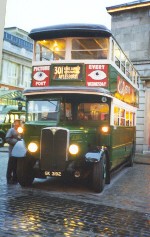
- The Prototype ST: ST1
- The First Standard STs: ST2 to ST517 (with gaps)
- The Watford Highbridge STs
- The National Lowbridge STs
- The Second Standard STs : ST518 to ST836
- The Tilling STs: ST837 to ST1027
- The Independent STs: ST1028 to ST1031
- The Bluebird STs: ST1032 to ST1039, and ST1070 to ST1084
- The East Surrey STs : ST1032 to ST1069
- The Autocar STs: ST1085 to ST1088
- The Amersham Lowbridge STs: ST1089 and ST1090
- The Country STs: ST1091 to ST1132
- The Lewis STs: ST1133 to ST1138
- The First ST: ST1139
- Not an ST: ST1140
- The Daimler STs: DST1 to DST5

ST 1 The LGOC prototype ST 1/1ST1
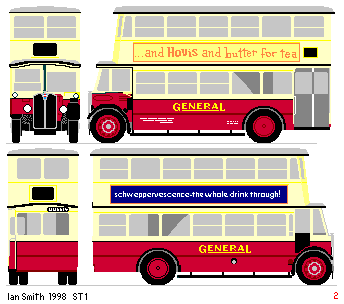 Introduced in October 1929, ST1 was a revolutionary bus for London.
The London area had to satisfy the exceedingly conservative demands of the
Public Carriage Office, that seemed implacably opposed to any innovation.
Introduced in October 1929, ST1 was a revolutionary bus for London.
The London area had to satisfy the exceedingly conservative demands of the
Public Carriage Office, that seemed implacably opposed to any innovation.
What was so new? Well, ST1 had a Chiswick-built body, H30/20R,
with a full width enclosed rear platform and an enclosed, straight, staircase!
It had roller blinds at front and rear.
The cab was square-cornered at first, and from new had a windscreen.
(This seems to have naughty on the part of the LGOC:
they only had permission for fifty buses to be so fitted, experimentally,
and had used all fifty on the LTs!).
(It also had a mirror at the top of the stairs,
but this was removed because too many ladies preened before it!)
The design of ST1 was used almost exactly on the Country STs (ST 1091-1132)
and the Autocar STs (1085-1088).
The fuel tank was changed onto the nearside before
ST1 entered service at Hanwell in March 1930.
At a later date the cab front was altered to match the rounded standard shape.
Eventually, through the overhaul system that treated standard bodies interchangeably
ST1 acquired the body that had originally been on ST 739.
It was withdrawn from Holloway (J) in Dec 1949.

ST 2 - 517 Standard STs (with exceptions), (Total 517). 1ST1/1
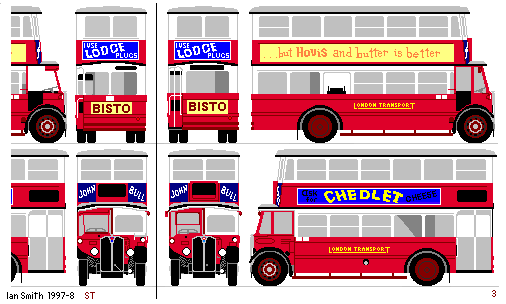
Standard 1ST1/1: early and late conditions. Drawing by Ian Smith
These were similar to ST1, but with the round-cornered cab,
and initially without wind-screens to comply with London regulations (!).
Originally they had the same minimal front blind arrangement as ST1,
with no rear display except for a number stencil on the rear bulkhead
and a decent blind over the door.
But the Public Carriage Office insisted that a more comprehensive display
be provided at both front and back.
A larger blind box was added to the front,
and a one line number and destination blind added at the back.
This displaced the number plate to the rear bulkhead.
Another difference made after delivery, while the rear was being modified,
was to provide a larger cut-out in the rear, for the doorway,
to allow escape in the event of a turn-over.
This in turn dictated a single platform window rather than the original pair.
They did all get equipped with windscreens eventually, of course.
They seated 49: (H29/20R). The fuel-tank was on the nearside.
Into service: The standard STs started service at Hanwell garage (HW) from
28th February 1930, on the 184 series of routes.
The first hundred went to HW for the 184, 218 (alongside new LTs) and 291.
Then 105 went to Hammersmith (R), also for the 184, and for the 11E and 25A.
Twenty-three of the R allocation were transferred briefly to Shepherds Bush (S)
for the 11E.
Seventy-three new STs went to Seven Kings (AP), from September, for the 25, 26, 126 and
148 routes, which actually needed rather more buses. These were scrounged from Hammersmith,
which then had the 23 back from Shepherds Bush in November.
| 1930 route no. | 1934 route no. | Route | Garages |
|---|
| 184 | 17 | London Bridge Stn - Southall | HW and R |
| 218 | 18C | London Bridge Stn - Hanwell Garage | HW |
| 291 | 91 | Liverpool Street - Hounslow Heath | HW |
| 11E | 11 | Liverpool Street - Shepherds Bush | R (and S) |
| 25A | 25 | Victoria - Seven Kings | R and AP |
| 26 | 25A | Victoria - Chigwell Row | AP |
| 126 | 25C | Victoria - East Ham | AP |
| 148 | 148 | Leytonstone - Dagenham | AP |
This first batch was followed immediately by a second,
that started arriving in October.
Half of these were bodied by Chiswick,
together with fifty by Strachans and fifty by Short Bros of Rochester.
They were first allocated as follows, to Leyton (T),
Chalk Farm (CF), Elmers End (ED), Norwood (N), Nunhead (AH), Forest Gate (G), Seven Kings (AP), Romford (RD), and Harrow Weald (HD):
| 1930 route no. | 1934 route no. | Route | Garages |
|---|
| 10 | 10 | Elephant & Castle - Abridge | T |
| 35 | 35 | Clapham Common Stn - Highams Park Stn | T |
| 68C | 68 | Chalk Farm Stn - South Croydon | N, CF, ED, AH |
| 168D | 68 | Kings Cross - Waterloo station | N, CF, ED, AH |
| 169B | 169 | Kilburn Park Stn - Norwood Junction Stn | N, CF, ED, AH |
| 82B | - | East Acton - West Wickham | AH |
| 125 | 25B | Ebury Bridge - Becontree Heath | G and AP |
| 186 | 86A | Stratford Broadway - Upminster | G and AP |
| 66 | 66 | Leytonstone - Gidea Park Stn | RD |
| 183B | 183 | Golders Green stn - Pinner Green | HD |
Three of the batch, ST462, ST464 and ST466 were fitted with AEC-Acro A155 8.1l diesel engines.
As these were longer than the petrol engine these buses exceeded the regulation maximum,
and needed special dispensation.
The extra weight reduced the seating capacity as well, down from 49 to 44.
They went to Willesden, but were found to be sluggish, thirsty and smelly!
They were moved to Harrow Weald just before the next annual overhaul, when the oil engines were replaced with standard petrol engines, and the seats replaced.

The Watford highbridge STs: (Total 9) 2/1ST9
ST 107, 111, 116, 129, 132, 135, 143, 152, 159.
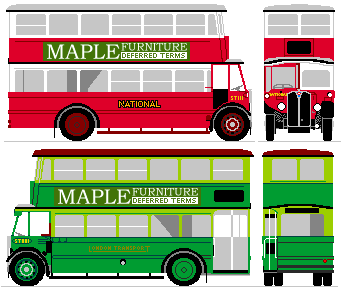 National needed modern buses for its trunk 301 route between Rickmansworth, Watford and St.Albans, where its open-toppers (NS and PS) were seriously outclassed by its rival Lewis with new Regents. It had been promised new STs in the ST501 series, but screamed to the General that it could not wait. It got its way, with these nine diverted from the original batch. So they were standard Chiswick H29/20R bodies with rounded cabs. In line with National conventions they lacked windscreens and garage plate holders.
Livery was standard LGOC red/off-white, with National fleetnames, until the LGCS takeover. Under London Transport they gained green and black, then two-tone green liveries, with "General" and "London Transport" fleetnames respectively. National fitted them with a deep valance below the cab roof, but it was not until LT days that they received cab glazing!
National needed modern buses for its trunk 301 route between Rickmansworth, Watford and St.Albans, where its open-toppers (NS and PS) were seriously outclassed by its rival Lewis with new Regents. It had been promised new STs in the ST501 series, but screamed to the General that it could not wait. It got its way, with these nine diverted from the original batch. So they were standard Chiswick H29/20R bodies with rounded cabs. In line with National conventions they lacked windscreens and garage plate holders.
Livery was standard LGOC red/off-white, with National fleetnames, until the LGCS takeover. Under London Transport they gained green and black, then two-tone green liveries, with "General" and "London Transport" fleetnames respectively. National fitted them with a deep valance below the cab roof, but it was not until LT days that they received cab glazing!
| 1930 route no. | 1934 route no. | Route | Garages |
|---|
| N1 | 301 | Rickmansworth - Watford - St.Albans | Watford |

The National lowbridge STs: (total 6) 3/1ST9/1
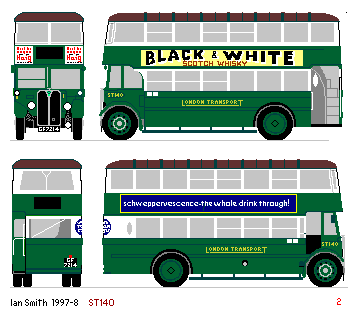
ST 136, 140, 141, 157, 162, 163.
National also needed to replace its open-toppers on the N6 route between Watford and Berkhamsted via Chesham.
Ordinary STs would not do, because of the low railway bridge near Chesham.
So Short Bros of Rochester built six 48 seater (L24/24R) low-bridge bodies with twin gangways upstairs and 3-in-a-row bench seats.
| 1930 route no. | 1934 route no. | Route | Garages |
|---|
| N14 | 336 | Watford - Chesham - Berkhamsted | Watford |
They were converted to diesel in 1950, lasting until 1952: the longest in-service survivors of the STs.
Many received modifications during their lifetimes, gradually acquiring Chiswick features: the cab doors went;
some received complete Chiswick cabs (that did not quite match the rest!);
windows were renewed, some receiving square -cornered frames while others retained the rounded-top style;
waist-bands, destination boxes and roofs were modified, so that by their final demise they were strongly individualistic.
ST 140, lowbridge ST, postwar condition. Drawing by Ian Smith
Modellers need to collect careful photo evidence of individual buses at a specific time: a generic model will not do!
(That's why the type drawing is of a specific bus).

The Metro-Cammell ST (Total 1) 1/1ST3
One of the STs was sent to Metro-Cammell to be fitted with an all-metal body. It looked much the same , but with square edges to the windows. It was somewhat heavier than the wood-framed versions, especially when fitted with a heavyweight rear bumper. It was originally on ST 211, then after overhaul on ST150. It survived to 1949.

The Second Standard STs: ST518 to ST836 (with exceptions)(1ST2)
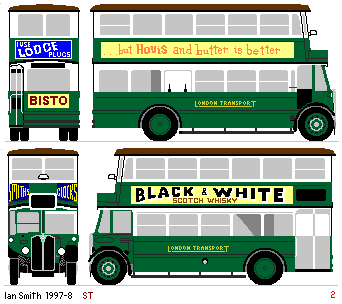
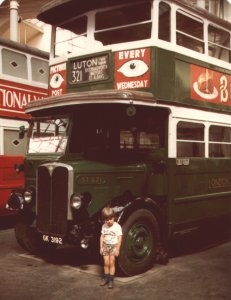
Country Area ST2/1. (Ian Smith)
ST 821 in the LT Museum, 1982. (Click for larger picture)
The ST2s had bodies essentially the same as those for the ST1/1s,
with the enlarged rear cutout, single platform window and improved destination displays,
but the chassis included upgraded steering, brakes and gearbox.
Ten bodies had the front destination blind incorporated into the cab roof,
like contemporary LTs, (ST2/1),
and a couple had a revised staircase that allowed two extra seats downstairs (ST6 and ST6/1).
25 of the bodies were built by Strachans and 17 by Shorts, the rest by Chiswick.
162 of this lot were actually owned by the Tramways (MET) Omnibus Co,
and ran briefly with their Metropolitan fleetnames until their next overhaul,
when they reappeared with a General fleetname.
The MET buses were allocated as follows:
| 1930 route no. | 1934 route no. | Route | Garages |
|---|
| 30 | 30 | South Hackney - Roehampton | T |
| 35 | 35 | Clapham Common Stn - Highams Park Stn | T |
| 106B | 106 | Finsbury Park Stn - Becontree | T |
| 8 | 8 | Colindale Stn - Old Ford | AC |
| 7 | 7 | Liverpool Street - Shepherds Bush | X |
| 166 | 166 | London Bridge Stn - Waterloo Stn | X |
| 118 | 18A | London Bridge Bridge - Acton Stn | X |
This allocation of the 35 route to Metropolitan freed some of the General STs
at Leyton, which were reallocated onto the 40, 100, 148 and 604:
| 1930 route no. | 1934 route no. | Route | Garages |
|---|
| 40 | 40 | West Norwood - Epping Forest | T |
| 100 | 10A | Elephant & Castle - Epping Town | T |
| 148 | 148 | Leytonstone - Dagenham | T |
| 604 | 34B | Edmonton Stn - Stratford Broadway | T |
ST 818-821 were built for National services at Ware, 2/1ST2, 1935
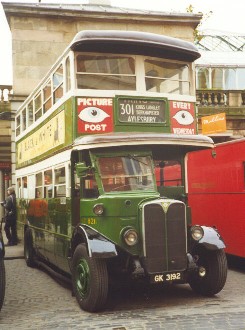
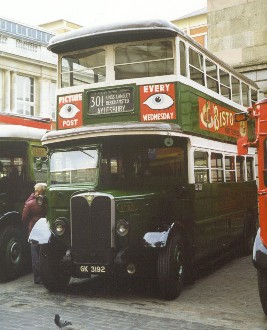
ST821 was preserved by London Transport.
After a spell in red livery the preserved ST has been restored to Country green and white livery,
with black mudguards and cheat lines, and a brown roof (here glistening in the rain).
Note the Country Area original-style small indicator panel. The Traffic Commissioner insisted on a larger box for the Central Area buses,
which ran for half their lives with part of the box masked off as a wartime austerity measure!
ST 821 is on the Covent Garden Piazza, outside the Museum, in December 1998, en route from
storage at Ash Grove garage to Acton Depot, the new LT store.
Photos by Ian Smith. Click for larger versions.
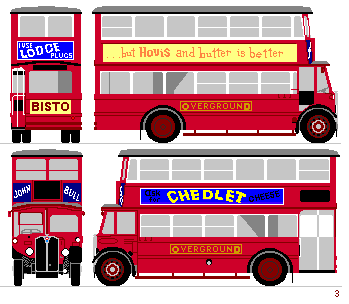
Overground
ST 822-836 were intended for Overground,
but most were replaced before delivery by Dennis Lances with Metro-Cammell all-metal ST bodies.
Most of the order went to LGOC ownership,
but ST822-826 were leased by Overground and appeared in their colours of darker red in more places, and white,
until repaint in March 1931 (ST 824) or October 1931 (the others).
In autumn 1932 twenty seven other STs were repainted INTO Overground colours, for use at Potters Bar (PB) on the 285, 285A and 629 alongside the Dennis Lances, replacing Leyland LB types.
General
Those for General service went to Norwood (N), Hendon (AE), Turnham Green (V),
Kingston (K) and Hammersmith (R) during the spring and early summer of 1931:
| 1930 route no. | 1934 route no. | Route | Garages |
|---|
| 2 | 2 | North Finchley - Catford | N and AE |
| 55 | 55 | Chiswick - Hanwell Garage | V |
| 65 | 65 | Ealing - Leatherhead | K |
| 25A | 25 | Victoria - Seven Kings | R |
| 52 | 52 | Victoria - Ladbroke Grove | R |
ST 746 was fitted with a Daimler transmission, with epicyclic gearbox and fluid flywheel.
It was allocated to the garage currently favoured with "experiments", Harrow Weald, for service on the 18.
ST 833/834 were transferred to East Surrey as 2/1ST2 in 1935.
After this series the LGOC continued building Regents, but on the new longer chassis, as STLs
The STs continued in service alongside increasing numbers of LTs and STLs.
Allocations of these to busy routes displaced some STs to other garages and routes,
so that soon they were a common type throughout the system.
STs at War
They should have been due for replacement in the early forties,
ten years being a full life for these light wooden-framed buses.
But they had to soldier on due to the war.
Their petrol engines and small capacity made them immediate candidates for storage, their thirst for petrol being prodigious,
so most were put into store at the outbreak of war, to be pulled back into service as the reality set in that workers increasingly needed bus transport,
especially in the suburbs and Country areas where sensitive war manufactories were being set up or relocated.
Gas Operation
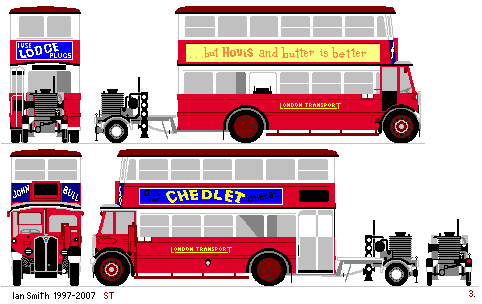 Many went into store, but some were converted for gas operation
and operated with coke-fired trailers for a year or two.
These trailers manufactured producer gas by drawing air through hot coke.
The gas was piped onto the bus, and along to a gas-tank in front of the front bulkhead,
and into the engine. The engines had to be modified, with an increased bore and compression ratio.
Petrol was still required for starting, with modified carburettor jets, and manual advance/retard of the ignition.
Garages had to be equipped for daily maintenance of the trailers, and procedures installed for firing them up
and attaching them to the buses.
These were started with petrol and then the gas supply was phased in and the petrol supply out.
Standing still in operation for more than a few minutes gave its problems too,
as it was engine throughput that kept the fire burning hotly and the gas producing.
Trailers were good for about 80 miles, so schedules had to allow for the swapping of buses,
as conductors were not expected to be stokers!
Special turning arrangements had to be made for the gas buses too. In general the performance was poor,
and gas buses were restricted to a few not too hilly routes. They smelled, too.
Many went into store, but some were converted for gas operation
and operated with coke-fired trailers for a year or two.
These trailers manufactured producer gas by drawing air through hot coke.
The gas was piped onto the bus, and along to a gas-tank in front of the front bulkhead,
and into the engine. The engines had to be modified, with an increased bore and compression ratio.
Petrol was still required for starting, with modified carburettor jets, and manual advance/retard of the ignition.
Garages had to be equipped for daily maintenance of the trailers, and procedures installed for firing them up
and attaching them to the buses.
These were started with petrol and then the gas supply was phased in and the petrol supply out.
Standing still in operation for more than a few minutes gave its problems too,
as it was engine throughput that kept the fire burning hotly and the gas producing.
Trailers were good for about 80 miles, so schedules had to allow for the swapping of buses,
as conductors were not expected to be stokers!
Special turning arrangements had to be made for the gas buses too. In general the performance was poor,
and gas buses were restricted to a few not too hilly routes. They smelled, too.
Grays garage was selected for a trial of twenty gas STs, to be used initially on routes 370, 371, 372, with five T's for the 375,
although the actual routes changed at about that time (autumn 1942).
All these Grays buses were red, incidentally.
Camberwell received a bunch for the 36 (West Kilburn- Hither Green) in March 1943, and
Epping some for the 392 (Epping - Ongar) and 396 (Epping - Bishops Stortford) in June 1943.
Two Waters and Tring received some in spring 1943 for the 301 (Watford Junction - Aylesbury)
and 302(Watford Heath - Hemel Hempstead).
Tring kept a petrol ST on standby to take over from late-running gas buses for the run out to Aylesbury.
Addlestone also received gas buses for the 461 (Addlestone - Chertsey), 461A (Walton - Ottershaw)
and 462 (Leatherhead to Staines), which had to be painted grey for operation to the Vickers factory at Weybridge.
Croydon received a batch in January 1944 for the 197 (Norwood Junction - Caterham Valley),
and Catford received some for the 36 and for the 124 (Forest Hill - Eltham).
There were advanced plans for other routes too, from Hertford and Clay Hall, which progressed as far as training,
and forward plans for many other garages. But the petrol supply situation eased markedly in 1944,
and the gas buses were all reconverted for petrol operation in the autumn of 1944.
Wartime losses and loans
The Central Area buses in particular suffered during the Blitz,
and again during the cruise missile (V1) and ballistic missile (V2) attacks
in 1944 and early 1945. Some were totally destroyed, others received spare bodies from the float,
and some received major rebuilds.
One new bus was assembled from spares,
and unusually took the number of a destroyed bus.
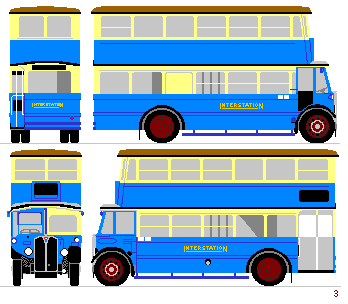 Many STs also went on loan to other companies throughout the UK during autumn 1942, including
Hants & Dorset, Wilts & Dorset, Venture (Basingstoke), Stockton Corporation, Bradford Corporation, Midland Red,
Coventry Corporation (which ran some on gas), City of Oxford, Cumberland, West Yorkshire, Crosville,
Yelloway (Rochdale), Lancashire United, Lincolnshire Road Car, United Counties, Young's (Paisley)
Northern Roadways (Glasgow), Red & White (Chepstow), Bristol Tramways, Rhondda, Pontypridd,
Caledonian, Enterprise & Silver Dawn, Trent, Halifax Corporation, Central SMT, West Bromwich Corporation,
South Shields Corporation, Bolton Corporation! They were returned in late 1944 or early 1945.
Many STs also went on loan to other companies throughout the UK during autumn 1942, including
Hants & Dorset, Wilts & Dorset, Venture (Basingstoke), Stockton Corporation, Bradford Corporation, Midland Red,
Coventry Corporation (which ran some on gas), City of Oxford, Cumberland, West Yorkshire, Crosville,
Yelloway (Rochdale), Lancashire United, Lincolnshire Road Car, United Counties, Young's (Paisley)
Northern Roadways (Glasgow), Red & White (Chepstow), Bristol Tramways, Rhondda, Pontypridd,
Caledonian, Enterprise & Silver Dawn, Trent, Halifax Corporation, Central SMT, West Bromwich Corporation,
South Shields Corporation, Bolton Corporation! They were returned in late 1944 or early 1945.
Interstation STs
On a happier note, a handful of STs were converted in 1944 for operating the Interstation services.
The Interstation Cubs were still busy entertaining the troops with ENSA,
so five STs had two bays of lower deck seats removed, in front of the stairs,
for luggage, and four received Interstation livery of primrose and blue.
ST 613 was the first converted and repainted, in November 1943, with ST164 joining it as the spare, converted but retaining LT red/off-white. ST 454 and ST757 were converted and repainted in November 1944 to release two Interstion Cubs for the Victoria-Croydon Airport service. ST771 joined them in April 1945.
They reverted to red when the Cubs returned after the war.
Postwar Make-do-and-mend
The STs continued to be overhauled, where possible, throughout the forties.
Some overhauls were contracted out to Mann Egerton in Norwich in 1946,
and Berkeley Caravans of Biggleswade in 1948, some buses being so done several times.
The shortage of buses was so desperate that only the worst examples were allowed to be scrapped in 1947.
But as more utilities became available they began to disappear,
a large swathe being cut through the standard buses in 1948,
and most of the remainder going in 1949.
No Central Area STs survived the onslaught of the
RT classes in 1949 and 1950,
although in some cases they were directly replaced by Guys that had in
turn been displaced by the new buses.
Many of them were scrapped by LT, body scrapping sometimes contracted out and the chassis returned to LT for parts reclamation.
Hundreds disappeared to the scrapyards of Daniels in Rainham,
who won the contract for their scrapping (or non-psv sale) during 1949, the year when most succumbed.
 In the Country Area, where the STs were the main-line type, the arrival of the first green RTs in July 1948 had dramatic effect. Those RTs went to Hemel Hempstead and Tring, ousting the STs from the trunk 301, 302 and 314. The STs mainly went to Hertford and Watford High Street, but these too were soon displaced by new RTs at Hertford (310, 310A), Watford (345, 346), Leatherhaed (418) and Grays (370).
The Country Area now had a surplus, which were transferred to the Central Area, still in green. Several congregated at Merton for the 93. Repaints into red followed for many of those kept to replace worn-out Central Area STs ansd LTs, although green trainers could be seen for some time..
Only one standard ST is known to survive in bus form, and that a Country one: ST821, seen above.
Another, ST798, sold during the war to the Royal Navy, became a trainer for submariners,
and was sold after the war to the Israeli Navy along with some submarines! It survives at the Clandestine Immigration & Naval Museum, Haifa.
In the Country Area, where the STs were the main-line type, the arrival of the first green RTs in July 1948 had dramatic effect. Those RTs went to Hemel Hempstead and Tring, ousting the STs from the trunk 301, 302 and 314. The STs mainly went to Hertford and Watford High Street, but these too were soon displaced by new RTs at Hertford (310, 310A), Watford (345, 346), Leatherhaed (418) and Grays (370).
The Country Area now had a surplus, which were transferred to the Central Area, still in green. Several congregated at Merton for the 93. Repaints into red followed for many of those kept to replace worn-out Central Area STs ansd LTs, although green trainers could be seen for some time..
Only one standard ST is known to survive in bus form, and that a Country one: ST821, seen above.
Another, ST798, sold during the war to the Royal Navy, became a trainer for submariners,
and was sold after the war to the Israeli Navy along with some submarines! It survives at the Clandestine Immigration & Naval Museum, Haifa.
They had put in a very creditable performance, most lasting seventeen or eighteen years
with the war years in the middle.
For a wooden-framed bus that was truly remarkable.
Lowbridge Reprieve
However, there was a reprieve for the lowbridge buses. London Transport still had no replacement for these.
The lowbridge Daimlers bought during the war and just after it were all fully committed,
and the lowbridge routes were all too busy to revert to single-decker operation.
So the lowbridge STs were pushed through overhauls, further "Chiswickising" them,
and received diesel engines from scrapped STLs. This kept them going into the new decade,
until they were eventually replaced by
RLH lowbridge Regent IIIs.
 Part 2: Tilling STs. Part 2: Tilling STs.

Acknowledgments For this and the following ST pages I have gleaned much information from
the following sources in particular
(a fuller list is given in the general bibliography):
- "London Buses 1929-39", Gavin Martin, Ian Allan
- "London Buses Before the War", Ken Glazier, Capital Transport
- "Last Years of the General", Ken Glazier, Capital Transport
- "London Buses and the Second World War", Ken Glazier, Capital Transport
- "London Transport Buses and Coaches, 1939-45, 1946, 1947, 1948, 1949, 1950", John A.S Hambley, various
- "London Bus File, 1946-9, 1950-4", Ken Glazier, Capital Transport
- "The London ST", Ken Glazier, Capital Transport
- "TLBExtra 1948", LOTS for 1948 data

 Part 2: Tilling STs. Part 2: Tilling STs.
 bus histories bus histories
 photo references photo references
 Bus Stop Bus Stop
 ST index. ST index.
 standard STs. standard STs.

|

 Introduced in October 1929, ST1 was a revolutionary bus for London.
The London area had to satisfy the exceedingly conservative demands of the
Public Carriage Office, that seemed implacably opposed to any innovation.
Introduced in October 1929, ST1 was a revolutionary bus for London.
The London area had to satisfy the exceedingly conservative demands of the
Public Carriage Office, that seemed implacably opposed to any innovation.







 National needed modern buses for its trunk 301 route between Rickmansworth, Watford and St.Albans, where its open-toppers (NS and PS) were seriously outclassed by its rival Lewis with new Regents. It had been promised new STs in the ST501 series, but screamed to the General that it could not wait. It got its way, with these nine diverted from the original batch. So they were standard Chiswick H29/20R bodies with rounded cabs. In line with National conventions they lacked windscreens and garage plate holders.
Livery was standard LGOC red/off-white, with National fleetnames, until the LGCS takeover. Under London Transport they gained green and black, then two-tone green liveries, with "General" and "London Transport" fleetnames respectively. National fitted them with a deep valance below the cab roof, but it was not until LT days that they received cab glazing!
National needed modern buses for its trunk 301 route between Rickmansworth, Watford and St.Albans, where its open-toppers (NS and PS) were seriously outclassed by its rival Lewis with new Regents. It had been promised new STs in the ST501 series, but screamed to the General that it could not wait. It got its way, with these nine diverted from the original batch. So they were standard Chiswick H29/20R bodies with rounded cabs. In line with National conventions they lacked windscreens and garage plate holders.
Livery was standard LGOC red/off-white, with National fleetnames, until the LGCS takeover. Under London Transport they gained green and black, then two-tone green liveries, with "General" and "London Transport" fleetnames respectively. National fitted them with a deep valance below the cab roof, but it was not until LT days that they received cab glazing!

 Many went into store, but some were converted for gas operation
and operated with coke-fired trailers for a year or two.
These trailers manufactured producer gas by drawing air through hot coke.
The gas was piped onto the bus, and along to a gas-tank in front of the front bulkhead,
and into the engine. The engines had to be modified, with an increased bore and compression ratio.
Petrol was still required for starting, with modified carburettor jets, and manual advance/retard of the ignition.
Garages had to be equipped for daily maintenance of the trailers, and procedures installed for firing them up
and attaching them to the buses.
These were started with petrol and then the gas supply was phased in and the petrol supply out.
Standing still in operation for more than a few minutes gave its problems too,
as it was engine throughput that kept the fire burning hotly and the gas producing.
Trailers were good for about 80 miles, so schedules had to allow for the swapping of buses,
as conductors were not expected to be stokers!
Special turning arrangements had to be made for the gas buses too. In general the performance was poor,
and gas buses were restricted to a few not too hilly routes. They smelled, too.
Many went into store, but some were converted for gas operation
and operated with coke-fired trailers for a year or two.
These trailers manufactured producer gas by drawing air through hot coke.
The gas was piped onto the bus, and along to a gas-tank in front of the front bulkhead,
and into the engine. The engines had to be modified, with an increased bore and compression ratio.
Petrol was still required for starting, with modified carburettor jets, and manual advance/retard of the ignition.
Garages had to be equipped for daily maintenance of the trailers, and procedures installed for firing them up
and attaching them to the buses.
These were started with petrol and then the gas supply was phased in and the petrol supply out.
Standing still in operation for more than a few minutes gave its problems too,
as it was engine throughput that kept the fire burning hotly and the gas producing.
Trailers were good for about 80 miles, so schedules had to allow for the swapping of buses,
as conductors were not expected to be stokers!
Special turning arrangements had to be made for the gas buses too. In general the performance was poor,
and gas buses were restricted to a few not too hilly routes. They smelled, too.
 Many STs also went on loan to other companies throughout the UK during autumn 1942, including
Hants & Dorset, Wilts & Dorset, Venture (Basingstoke), Stockton Corporation, Bradford Corporation, Midland Red,
Coventry Corporation (which ran some on gas), City of Oxford, Cumberland, West Yorkshire, Crosville,
Yelloway (Rochdale), Lancashire United, Lincolnshire Road Car, United Counties, Young's (Paisley)
Northern Roadways (Glasgow), Red & White (Chepstow), Bristol Tramways, Rhondda, Pontypridd,
Caledonian, Enterprise & Silver Dawn, Trent, Halifax Corporation, Central SMT, West Bromwich Corporation,
South Shields Corporation, Bolton Corporation! They were returned in late 1944 or early 1945.
Many STs also went on loan to other companies throughout the UK during autumn 1942, including
Hants & Dorset, Wilts & Dorset, Venture (Basingstoke), Stockton Corporation, Bradford Corporation, Midland Red,
Coventry Corporation (which ran some on gas), City of Oxford, Cumberland, West Yorkshire, Crosville,
Yelloway (Rochdale), Lancashire United, Lincolnshire Road Car, United Counties, Young's (Paisley)
Northern Roadways (Glasgow), Red & White (Chepstow), Bristol Tramways, Rhondda, Pontypridd,
Caledonian, Enterprise & Silver Dawn, Trent, Halifax Corporation, Central SMT, West Bromwich Corporation,
South Shields Corporation, Bolton Corporation! They were returned in late 1944 or early 1945.
 Part 2: Tilling STs.
Part 2: Tilling STs. Bus Stop
Bus Stop ST index.
ST index. standard STs.
standard STs.